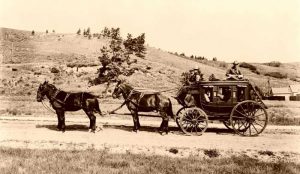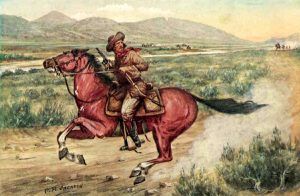By William Daugherty, for the Reno Evening Gazette in 1891

Stagecoach Driver
The old pioneer stage drivers were nearly all possessed of some marked characteristic that distinguished each from the other so that they could almost be recognized in the dark. Some would rarely ever speak; others would talk a little to be social, or for the same reason, listen attentively to a stale joke that was dinned in their ears every day by smart alecks traveling at other people’s expense; while some were full of Joe Miller jokes, which they would repeat daily “just to see some sucker bite.” All had pride in their calling, petted their “stock” and would beat the opposition, even though they had to “pound ’em on the back” to make time.
Among the crack whips, Billy Blackmore was noted for his devotion to duty; his foot was always on the brake, with stock always in hand and whip ready to touch a leader. Billy was so attentive while on duty that his nightmares were a repetition of his run, and when asleep his dreams were always of the dangerous places on the downgrades. At such times, he would pull himself up by the blankets and press the footboard off the bed, muttering “Whoa, there! whoa!” believing all the time he was bearing down on the brake. He was a terror to the landlords, who finally adopted the plan of building bedsteads that he couldn’t kick down.
Baldy Green was noted for his ill-luck in being selected by the road agents, or highwaymen, for robbery. In Six-mile Canyon he was stopped so often that the stage company concluded he was either in with the gang, or else a hoodoo, and they transferred him to the Austin, Nevada drive. That broke his heart and he left the road and went to hauling freight in Pioche.
Tom Reilley Was a wag and always “joshing.” He had a ready joke for everyone, even when wakened out of his sleep. On one occasion, when his drive ended on the new road from Eureka to Palisade, at midnight, at a station consisting only of a corral, when the stock was cared for, Reilley laid down and was soon sleeping. Waking at the hostler’s movements, Reilley yawned and said “Tim, for God’s sake, put up the bars’ or we’ll both take cold.” His favorite expression of approval or condemnation was “He’s a lizard,” and his meaning of its application was the manner in which he said it and squinted his eyes. His eyes were weak and always half-closed. Coming out of the hotel at Palisade one noontime from dinner, he stopped to look at two Italians lying asleep on the front stoop. One of them, made restless by the flies, raised his foot and gave a little kick, at which Reilley said to his comrade, “It’s alive Billy, I saw it move.”
Vic Koensin was noted for his earnest expressions uttered in a deep guttural of broken German. He possessed great powers of endurance, and during the muddy roads of the spring break-up in the Reese River valley, he was frequently out on the box twenty hours in his drive from East Gate to Austin. It was a daily drive, and Baldy Green said he walked around the rest of the day for exercise.
Dave Red was noted for his thin, cadaverous look, and ghastly smile when the bottle was passed, at which he would say “Here’s a go,” and after taking a swig, pull up on the lines and start the team on a spin to the next raise. We rode with him once to Idaho, and in crossing the Owyhee River went over the ferry ahead of him, leaving a bottle concealed in our baggage. An hour afterward, the stage got across and Dave — well he had found the bottle. We dropped it under the wheel to save his neck, and when we reached the end of his drive at Jordan Creek, he was sober as a deacon, and merely said “Take care of yourself Billy till I see you again.” Poor Dave, he was found dead and boiled to pieces, a year or so afterward in a hot spring at Keosin’s Station, midway between Austin and Battle Mountain.
Jim Miller was known for his striking dress. In stature over six feet tall, his clothing gave him a look as grotesque as a clown. But, his clothes always fit him and were made to order under his special directions. In winter, he wore a long blanket overcoat and pants, with the wide stripes arranged for cuffs and collars and high watermarks. The buttons were big silver dollars, and across his bright red vest was a silver watch chain with links like a trace chain, which went clear around his neck and weighed four pounds. It was further weighted down with silver horses. The watch was a monster one and had cases so thick that he could run his coach over them without endangering the works. Of course, he wore a white beaver hat of the finest make — all the drivers did that in those days — and as a further mark of oddity, he wore very high-heeled boots with soles an inch and a half thick. When he would arrive at Austin with his fast freight wagon from Virginia City, he attracted as much attention as the camel train that was then used in freighting. And, he enjoyed the notoriety better than Barnum ever did “The biggest show on earth.”
Uncle John Gibbons was the hero of the Sazerac Lying Club, and to him is attributed the proposition to graft grapevines onto the sagebrush, and thus turn Nevada into a vast vineyard.
Reese Hawley was noted for his daring bravery as a Pony Express rider. After it was succeeded by the Overland Stage, he pulled the reins over a team in and out of Austin, until he secured a moderate nest egg, and then resigned and retired to an Iowa farm, and was noted as one among the few of the old boys that saved a competence for his old age.
By William Daugherty article in the Reno Evening Gazette, June 3, 1891. Compiled and edited by Kathy Weiser/Legends of America, updated June 2021.
About the Author: Written by William Daugherty, for the Reno Evening Gazette in 1891. The Reno Evening Gazette was first published on October 12, 1876, and continued for the next 107 years. In 1977, it was merged with the Nevada State Journal and continues to exist today as the Reno Gazette-Journal.
Also See:
Pioneers on the Nevada Frontier (Reno Evening Gazette)
Nevada Mining Tales (Reno Evening Gazette)
Pioche Land Jumpers and the Death of Jack Harris (Reno Evening Gazette)
Violence on the Nevada Frontier (Reno Evening Gazette)


